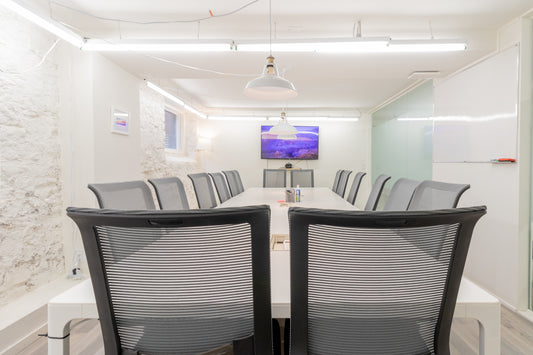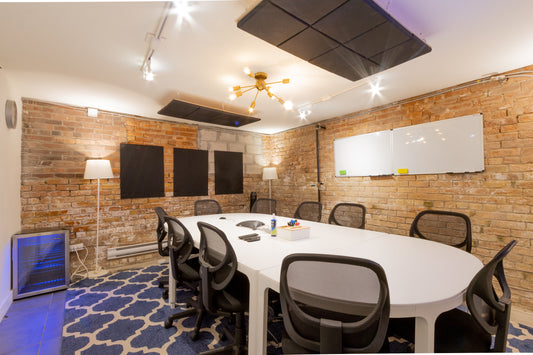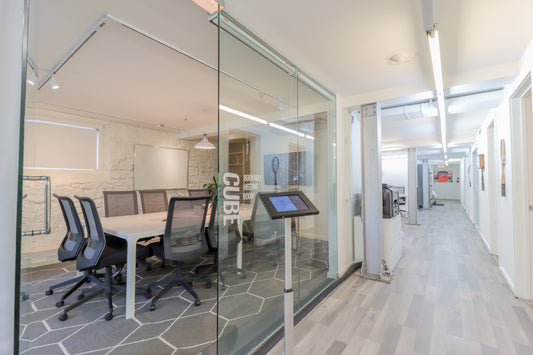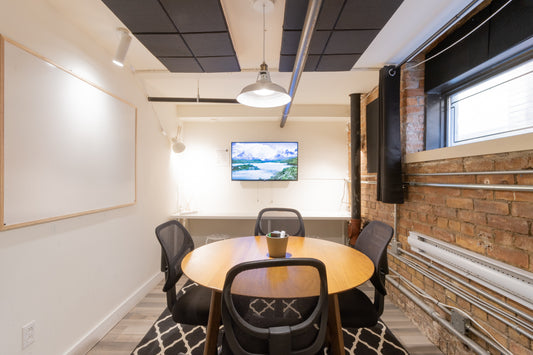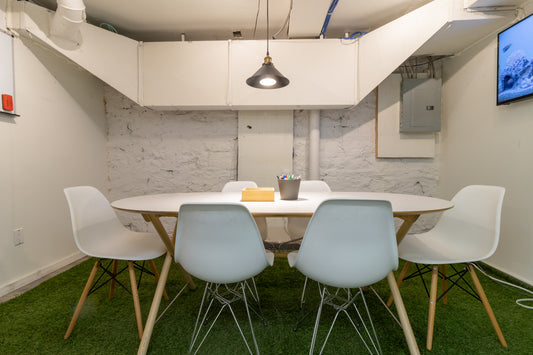BEworks is the world’s first commercial consulting team dedicated to the application of Behavioural Economics to real-world challenges. Recently the firm developed a Work From Home Diagnostic Tool – we caught up with Kelly Peters, BEwork’s CEO and CoFounder, to hear more about what inspired the Tool’s development and how they work with clients to apply its principles.
In a rush? Here are some highlights from this conversation
- Behavioral economics and data-driven decision-making. (0:00)
- Workplace dynamics, team growth, and remote work during COVID-19. (4:51)
- Work-from-home productivity and creativity. (12:41)
- Work-from-home challenges and innovative solutions. (19:22)
- Team communication and productivity in remote work environments. (25:58)
Spend time with this conversation - here's the full transcript
Qasim Virjee 0:00
Get. back to another installment of a new normal, I'm start Will's founder and CEO Qasim Virjee. And in this session, we're sitting down with Kelly Peters, who is the CEO and co founder of B, E works. Going to be short, because I know we're both pressed for time today. But it's a pleasure having you. And I'm really excited to hear about, you know, be works and the work that you guys are doing right now. Yeah,
Kelly Peters 0:45
it's wonderful to be here, I think that you've always had some really cool community building approaches. So I'm super happy to be a part of yet another one of your ways of creating community. It's about behavior, it's about understanding how and why we make the decisions that we do to the best of our ability. And it's about impacting and influencing that behavior. And so driving that behavioral change, and then that is all sitting on top of this framework, that's called the scientific method. And that's where data starts to, you know, kind of show itself and play out. But the thing that's really neat about the scientific method is, you know, actually data, data has all of these different characteristics, there's, there's data can be super simple. It could be how many times somebody walks past my window, and I just write those observations down, it's something that I'm seeing. Or it could be even more basic than that, which is, let me make a guess, on how many times people walk by my my window, and causing my dog to bark, which could happen. So that's just based on my guests my prior experience. So that could be data to what that number is. But then data can get very fancy data can take on this whole other level. First of all, we can improve it with really robust technology, maybe I use like a digital counter, I do sampling across different days and different periods. And then I can maybe create averages based on the weather. So now data can become more and more sophisticated. But then data in its most sophisticated form is as a function of a randomized control test or an experiment. And that's when we've designed data in such a way that in this case, we're just looking at and gathering observations. But in the case of evidence, we've actually designed a randomized control test. And it now has all of this peer review that went into the process, lots of people in like influencing the design and adheres to these scientific standards. And that data, what's the day that we can have the most confidence in because now it actually even has a different label, and that's called evidence. So B E works is in the business of changing people's behavior to get better outcomes. But we don't just recommend, instead, we design experiments that let us test our hypotheses about what might be effective.
Qasim Virjee 3:35
Yeah, and I think it's, it's interesting, because it's been how many years now that the consultancy has kind of formed into a practice. Yeah,
Kelly Peters 3:44
so the idea started in in 2010, I had built a behavioral economics team in 2008. So I've been at this for a little while.
Qasim Virjee 3:56
Yeah, about a decade. Just over that. Yeah.
Kelly Peters 4:00
Yeah. I'm still feel like a start up, though. Just so you know. No, that's
Qasim Virjee 4:04
good. That means that you like what you do. Or at least this of like, the burning motivation, kind of like get stuff, get stuff done. But okay, so how we came into contact, of course, was when the E works for a short time was resident here at start well, and, and you know, so you existed somewhere before you existed somewhere after that's where you guys are now, although, I want to hear a little bit about the place, I guess, now that you call home, and then we can talk about your team and how you guys are dispersed a little bit and where you exist. Before we get into the COVID stuff.
Kelly Peters 4:41
Yeah, my real estate journey has been fun. I'll even I'll even add a little bit more to that I call just frankly, because I just love how I how that journey evolved. We started in a space that I like to call the cupboard under the stairs. And it was really neat how all of that evolved. And it was one of those things that showed me how important space is to our sense of connection and our ability to collaborate. And when we started out, we had an office that was in the former dean of the Rotman School of Management at University of Toronto, I was part of an organization called the Institute for competitiveness and prosperity. And they had some nice offices at Blore and Avenue Road and kindly let us sublet this office within, you know, one office within that overall office. And it was a very small space, but at the time, it was just me and two of our co founders, who were only there part time. So it really it was just me, sitting at a desk, full of the office going, What the hell have I done, and, and we grew, and I hired a person we hired, another person business started to come in, it got to the point where there were eight of us in this very small room. And it was this cupboard under the stairs, and we shared our desks, even we share it, we shared, you know, practically shared our pencil case, because it was so small, we were all able to reach the same pencil case like. And then what happened was, the Institute had their new formal headquarters. Finally, were built at University of Toronto, and they moved, and we had access to the rest of the 3000 square feet or so for the remainder of the of the lease. So here we are, with these nice, nice view on on Bloor Street of you know, the Raum and the city. Yet, instead of people spreading out to those different offices, people were coming in, the eight people would still show up in this small cupboard. Instead of starting to occupy the other desks, we aggregated into this tight little hive. And it stayed like that for a month. Until one day, I was like, this is just so curious. To one day, I wrote everybody's names on pieces of paper and taped them on these, this space was set up with all of these independent offices until I actually pasted their names did people finally start to move apart spread out in in the real estate. So that was such an interesting phenomenon for me to see how people wanted to be in proximity. I mean, we understand that now more than ever, and it's it's important for us to how, you know, figure out how the heck we're going to satisfy our social needs to be near one another. And of course, there's a balance there's a balance between the solitude that we need to think with the the need that we have for that social interaction. So it's a very interesting time. So yeah, we after we outgrew that space, we needed a new home and we moved into a heritage building we outgrew that space. And we also had crazy stories there we had a mop room with a giant mop like the big yellow industrial mop bucket and the cleaning crew always kept it filled with like grey water and Lysol. It just It was horrible. And it was in this in along with our server and stuff was the most It was literally the mop room. And we had garbage cans like right outside that space and then our kitchen, we we got to the point where we were taking meetings in what was called the mop room and we put it into our scheduling system that was their call booth. The mop room, we had to actually take calls in there too. we outgrew till till we found a new space, which was the former Museum of Modern Art at Queen and and Shaw. But we have this period while our space was being built and chant transformed from you know, one of the coolest hubs for amazing Canadian contemporary art into our hub for for science and that took time and and that's what led us that's what led us to you and I met some of the coolest people I met I met a really cool musician who's become a great friend. Gurpreet who did, we ended up talking about technology and music and I met some of the other really cool tech startup folks in your space. So it was it was a fun fun home for us for a while.
Qasim Virjee 9:58
But Kelly I How many people are on your team? Now? How many people work at me works?
Kelly Peters 10:03
Yes, we've got about 50 people. They're not all in Toronto, we've got a team in Tokyo, and we've got a fellow in Bogota. And we have an affiliate in Nairobi. And really,
Qasim Virjee 10:22
yeah, of course, I used to live there. So that's, that's close to home. My brother's still in Nairobi.
Kelly Peters 10:27
Awesome. Good to know. Because there's always a need for for networking and connections and relationships on the ground in these different places. Because where people are matters, and being together and having our network is, is so helpful. So it's, it's such a awful time for so many people right now. It absolutely is. But if we can take time to reflect and I hope, you know, as your communities is listening to this, like I really respect the fact that you know, people are listening, it means you're curious means you're thinking about things means you're trying to learn new ideas. And I miss doing that in person. But I love the fact that you've structured this podcast as a way to just keep those dialogues going. Thank
Qasim Virjee 11:17
you. Yeah, no, it is, I think dialogue is really so important to not only the human experience, but of course to work that is fulfilling people need to be able to communicate, you know, and have the freedom to do so. So also an under note in some of these conversations I'm having with technologists that will go live in the next two weeks, is really about like how are these tools being provided? Post COVID. And during COVID? You know, what, what actual solutions are people creating to enable digital communication in ways that we haven't yet conceived of which were inspired by this period? So yeah, it is, it's a it's a great time to be chronicling innovation. But it's a terrible time for people who want to be together. And I think you use the word that I'm using a lot these days, which is proximity, I like that word. And, and I think it's interesting to hear the real estate story of kind of, ebbs and flexes of, of your team growing and spaces and then being globally dispersed. So there's got to be, you know, that value that you've had for working remotely and working with people who are not physically in the same office. Of course, this seems to have possibly informed the diagnostic tool that I wanted to scratch your brain on, which you guys have, have created. So I'd love for you to tell me a little bit about the work from home diagnostic tool.
Kelly Peters 12:41
Yeah, I'd love I'd love to share some of that thinking. It was definitely born from our natural desire at FBE works, which is to understand, you know, to see a dynamic coming and then understand as best we can, that from a scientific perspective, and we're not in the position to build, you know, the technological solutions, but our job is to is to understand the behavior. So, so we, we build the tools, and we have like incredible cloud computing, communication technologies and capabilities, and there's still so much innovation in that area. But when it comes to making those things successful, there's so many tools, which ones do we get people to use, there's so many ways to communicate, which are the right ones for the right kind of communication, we start to move into the kinds of things that we specialize in. So for instance, we find that there's a tremendous amount of anxiety that is being caused, by the way we're managing our communication habits. Many people tend to just, you know, email comes in, they respond, a direct message comes in, they respond. And one of the things that we know is that has a has a negative impact on our anxiety level, we keep switching. And it inhibits our ability to have focused work, which lets us think better get into the flow, start to tap into our creativity and ideation. And so instead, we need to look at things like there's this kind of quirky term that's been developed called bursty communications, which is instead we need to have the discipline to schedule when we're going to look at our our inbound communications as a way to stabilize those constant interruptions or the temptation to constantly look to see if we've received new messages. We need to do that because as I've said, it increases our anxiety we might not be aware of that impact, and it decreases productivity and inhibits our creativity. So we might have built these wonderful tools and technologies that, you know, short form long form. But we need to look at and take into consideration the psychological and behavioral aspects of these technologies. And that's what, that's what we do.
Qasim Virjee 15:20
Yeah, no, it's a massive topic. How I guess the, the the issue of the how do you assess the damage to the daily flow, and also to the general mind, state of employees or staff or people, even if they're no matter what the hierarchy of, of a team is, if it's used to this kind of like, push driven mandates within an organization, being remote opens so much room up for assumptive behavior, and people assuming a certain response time, and a certain answer ability. And, and it's, it's kind of scary, I think it's scaring a lot of people to feel like we're in this like, post industrial reality of stamp stamp paths, if not, push the button over and over. And that's your new job. So tell me a little bit about the diagnostic tool and, and how it works.
Kelly Peters 16:17
Yeah. So just as we've identified the five factors that we think that organizations need to take into consideration when it comes to understanding the employee experience with regards to work from home. And those five dimensions cover some, some are about the individual and how they're feeling and doing, and some are about how individuals are doing in terms of the team. And some are about the relationship between the firm and the individual. So those those five dimensions are well, first of all, it's around, you know, productivity, how how, what are the impacts to productivity, and I just spoke about, I just spoke about that. We like to look at that from two dimensions. One is just how productive you are. But it's also how creative you are as an individual. So we we put those things together. And we think that some of the big challenges that that we face are, first of all, overcoming organizational biases that generally tend to assume that employees are going to be less productive and less creative working from home than they are at the office, when in fact, there's lots of really neat studies that had been done prior to COVID, 19, empirical work, looking at things like people's performance when they were working from home. And generally the studies indicate that that people can be more productive and more creative. And it's, it's a variety of reasons, everything from reduce commute time, decrease stress, to having the potential ability to work more in solitude, and be free of the of the distractions that keep us from thinking about new ideas are new ways to tackle problems. So so this is the first dimension that we study, which is around how do we recognize those potential barriers and biases around employee creativity and productivity, but then recommending solutions that can actually help help strengthen it and optimize it even more. Some of that is just like decreasing people's likelihood to engage in multitasking, increasing people's likelihood to engage in activities in a focused way by booking time to just do one thing. So if you're multitasking right, now, it's harder for you, we can give you a test of your of your working memory on what you recall from the conversation. And it's going to be lower than if it was focused and you did things like doodle or draw or did other kind of mindless activities while you're listening. So it's about giving that kind of advice. Another another dimension is around trust. And there's some things here that are I think, for I know that part of your community is small business owners, and they manage teams and they're probably it's a very, very complex time for that. One of the things that our research shows is that when business leaders are able to help employees to understand the resilience and the recovery potential of the firm Then employees can feel more connected. And in particular, if if that communication is done in such a way that employees are able to see the connection between their effort, and the impact that they are having on that resilience and recovery potential of the firm, then they are more motivated, probably than ever, to continue to work hard, and to help do their best that they can to facilitate the success of the firm. So, so addressing that kind of operational transparency is very important.
Qasim Virjee 20:41
Work from home. It's funny, because I know, that's fine. I just had a conversation actually, with Ginza, three, which is a consultancy, that specializes in systems for the transmission of knowledge. They help all sorts of organizations including like, the body that manages the LA airports, to, to create peer review systems and create on the job training mechanisms, and, and also promote cultures of knowledge exchange in organizations. And this was a big thing that that conversation yielded, as well as the insight that a lot of their clients that they work with, are dealing with this, this is a time when people feel so set apart from the community that normally justifies their sense of belonging to accompany. And in order to strengthen that or, or bring that back again, there has to be this kind of return to onus, a sense of people seeing that the output of their work is resulting in a collective good, it feeling that that's really something that's so sticky and making someone feel part of an organization.
Kelly Peters 21:55
Absolutely. Another dimension, then of our tool is around us social connection. And this one's particularly interesting, around work isn't just showing up, to go in and do your job. It's not just about having meetings to you know, tackle something at hand. But there is this element in need for social connection. And that's, you know, acknowledging a colleague's birthday, it's asking them about their family, it's having a laugh over coffee. And this is one of the most complex areas of working from home that we need to continue to tackle and requires companies to be bold, in order to help protect the culture. And we've we've done a number of things. And I think that we need to, you know, continue experimenting with them. So long as the so long as the lockdown continues, but also as as work from home becomes potentially a hybrid model, right? A permanent way of working, we need to figure out different ways to experiment and have fun with ways to sustain and create social connection. And I've been, you know, I've done all kinds of really fun, crazy things that I hadn't ever, you know, we hadn't done before, like, I don't know, if you've done any of these zoom parties, you know, where there's a DJ, and folks, you know, costumes and dance in their living room. And so I've done, I've done a few of these. And, you know, the first time was very novel The second time, you know, it was really into the DJ, but, you know, third time, a little bit more of like, let's just play the music. But standing in front of the computer, you know, trying to do some moves, is too much of a spectator activity. And so Nevertheless, I was I was very excited to do this the first few times, you know, one or more formally organized events. And another one, you know, a friend had pulled together was a way to connect us all and have some fun. But you know, how and what should we continue to do that facilitate social connection, but isn't lame? Right, exactly. So we've got so many incredible artists and performers and entertainers and event producers that are you know, unemployed now that I think companies to bring some of these folks back into brainstorm, what are some other ways to help facilitate and foster that social connection? So I think that there's an important opportunity there for for more innovation.
Qasim Virjee 24:53
Oh, I totally agree. It's something that I was ever running conversation on. And we did one episode with my friend Tara Who's a festival director in Vancouver, the 5x festival. And this will be their first year taking their entire festival which has 1000s of participants online. And they're more excited than ever to produce it. Now, it's not something everyone can do. And not everyone in that industry is able to reinvent themselves using technology. But, but some people who are looking to innovate at this time are definitely coming up with with tricks and means that will not only set the course for their audiences to expect from other vendors and producers that they interact with, but, but also hopefully inspire other people to to create ways for for us to interact in a fun way, for sure. Yeah.
Kelly Peters 25:47
So so the, the fourth one, then, of the five dimensions that that are in our tool, are looking at collaboration itself. And, you know, we are losing so many things, within this communication mechanism, some of it we studied, and we thought would be worse than the data seems to suggest that it is. And that is things like, when we're hosting our meetings on this channel, do we have people that are like the loudest voice and crowding out the ability to have that, you know, true roundtable effect, you know, appropriate based on the content and ideas that people have? We were worried about that. And we were also worried about teams, potentially becoming victim to groupthink. And that the ability to provide challenge and dissent within that group, we were afraid that this would be harmful to team decision making. And so these are a couple of the biases that we've been studying to make sure that they don't, you know, corrupt, and already fragile process around, you know, healthy, robust team decision making. So we're continuing to track that some of our early data suggests that it's not as much of a problem as, as our early intuition, but more More to come on that. And so those are things that are again, a part of our tool. And then last, but not least, it's psychological safety. And everyone is very nervous about their job. And some of the things that we used to be more comfortable doing, you know, sitting down with the manager and going, hey, you know, this thing isn't working or grabbing a colleague and said, hey, you know, we've got to iron out some issues, you know, all those things that we used to do, when, from our point of view, you know, hey, there's an opportunity to improve or communication or process or, you know, whatever it is, those kinds of conversations are a lot harder to do now. Oh, for sure.
Qasim Virjee 28:13
Managing spontaneity, like spontaneity is something with these tools like zoom, and one on one conversations, they become so loaded, you're right, everyone has their time in the queue to speak. And if it's the wrong thing, it's like, oh, no, they're going to record this and play it back. And I'll have said the wrong thing, or use the swear word, or the impact of people's participation in conversations feels so much more loaded.
Kelly Peters 28:37
That's right. That's right. So this, this fifth dimension, then is something else that we've we've put in our tool. So I mean, just, you know, just stepping back, when we look at, you know, many companies are of course, so like, Hey, how's our team doing with work from home? How are people doing, but they're constructing those tools in such a way that they're they're not very first of all predictive of impact on things like productivity and job satisfaction and psychological safety. Our tool is built on these more robust measures, literature review, determining the right factors, the right measures, the right skills. You know, it's the it's the scientist approach and the behavioral scientist approach to building a tool that companies can use to really get a reliable pulse check on how the team is doing and understand where they should focus their their efforts.
Qasim Virjee 29:40
Is their content coming out from this experience of working in this way? And from this, creating this tool and using it that people will be able to digest through through whatever you publish or is this something that primarily gets communicated through a consultancy engagement.
Kelly Peters 30:00
Yeah, it's both. We have launched a webinar that's online where we talk about the core tool and its components. And so that's now online. And actually, if I can make a plug, Danna reality, and I are doing the second phase of this work and sharing our research on a webinar on Tuesday. Let's see, believe it's a I should I should know all of this, my dates and times, but it's it's coming up and love to be able to extend an invitation to your crowd, but it's 11am. Eastern Time, on Tuesday, May 26. And that's promoted through ve works.com. And then through our social media channels, and people can register and it's a, it's a free knowledge sharing event. And then our clients who do engage us through the survey of their own workforce, get access to benchmarking how other companies that are similar dissimilar, are doing and again, it's our point of view on areas that are strong or areas that are weak.
Qasim Virjee 31:20
Fascinating. It's exciting. I'm glad you did plug that because we'll share that through our socials and hopefully attached to this video as well. So if anyone's interested in learning more, they can see the webinar. I'm guessing that you'll have that available post session for people to playback as well. Yes, we will. Excellent. Okay. Well, we'll definitely catch up more. I know that today's schedule is a little loaded. So you've got another engagement. But, but we should keep the dialogue running through this and post this unfortunate period that we're all trying to figure out. Yes.
Kelly Peters 31:53
Awesome. Thank you so much. It was a pleasure. Likewise,



